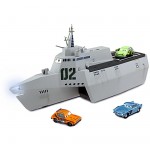There may be no greater threat to international security, maritime or land-lubbing, than enormous, airborne sharks that can tear through office buildings like water:
Shark week is coming to U.S. television viewers.
Maritime and naval stories with a dash of comedy.
There may be no greater threat to international security, maritime or land-lubbing, than enormous, airborne sharks that can tear through office buildings like water:
Shark week is coming to U.S. television viewers.

Our present-day pilotless platforms have been branded “drones” to their detriment. The word communicates a lack of adaptability or agency. For an increasingly automated fleet of machines, it denotes monotony and mindlessness: the droning of engines as a Predator lazily loops above the mountains, observing friend and foe alike. “Drone” is inappropriate for an ever-expanding suite of devices with greater close-in roles in combat. An AlphaDog, an EOD bomb-disposal bot, the DARPA Crusher, and the Battlefield Extraction Assistance Robot (BEAR) are not “drones.” To better describe our new combat compatriots and better comprehend their multitudinous uses and designs, let us properly christen our autonomous allies.
ComBot is the accurate alternative to “drone.” An obvious combination of Combat and Robot, it describes our soon-to-be automated assault associates in an easy-to-digest term. The name has a practicality lacking in most military monikers. It is not a shoe-horned acronym such as Close-In Weapons System (CIWS) pronounced “see-wiz” rather than “ki-wis” or “cue-z”. What layman would ever think of a high-tech Gatling-gun when they hear “CIWS”, or a pilotless aircraft when they hear “UAV”? However, the wordplay of ComBot makes the backing concept immediately recognizable. A rose by any other name may be just as sweet, but people abandoned the term horseless carriage for a reason; let’s update our language to match the concept.
Matt Hipple is a surface warfare officer in the U.S. Navy. The opinions and views expressed in this post are his alone and are presented in his personal capacity. They do not necessarily represent the views of U.S. Department of Defense or the U.S. Navy.
 What do kids do when they get new set of Legos? Immediately start construction. Maybe in the beginning they will follow the assembly instructions, but soon discipline breaks and creativity wins. LCS, thanks its modularity, resembles a Lego set in some respects. As Christopher Cavas noted on Information Dissemination:
What do kids do when they get new set of Legos? Immediately start construction. Maybe in the beginning they will follow the assembly instructions, but soon discipline breaks and creativity wins. LCS, thanks its modularity, resembles a Lego set in some respects. As Christopher Cavas noted on Information Dissemination:
Will some of the mission equipment not work well? Probably. Have something better? No problem. Change it. Bring stuff in and install it, ship stuff out, bring in different stuff.
While awaiting finalization of already defined mission modules, why not think about additional ones? For example, the SuW module has been designed to counter swarm attacks, based on experiences from Middle East operations. It would probably work well in Strait of Hormuz or even in Far Seas as defined by Dr. Andrew Erickson. But would it be as effective in China’s Near Seas? Later at Information Dissemination, Wayne P. Hughes summarizes his arguments in favor of distributed offensive power and risk. LCS is not conceptual like SeaLance, but installing Harpoons as a part of next SuW module could be a step in line with his reasoning.
ASW is another example. Although it stands for anti submarine warfare, is the conventional submarine the only underwater enemy of the future? If US Navy is pursuing autonomous robot projects, we should assume that our opponents are doing the same. The question arise what will be the best defense against future armed Bluefins or underwater gliders turned into intelligent mobile mines? Even if not armed, underwater robots are dangerous as scouts providing enemies with essential information. Will we need anti scouting module as well?
Recognizing all the challenges related to their development, inventing new modules seems to be unrealistic. Here our analogy could again be helpful. The inspiration for the whole concept of modularity came from Denmark, as did Legos. What Danes did with their StanFlex modules to minimize complexity and risk, was to take EXISTING systems and packed them into standardized container, a true Lego approach. So let us allow our creativity to wander, under subtle supervision of reason.

Before the Founding Fathers put pen to paper, formally declaring the independence of these United States, there was a navy. This is a nation birthed by a navy. Our vast nation started with the intrepid explorers, pilgrims, and entrepreneurs who first crossed the vast and often terrifying Atlantic to reach our shores. As the colonies developed, the journey became mainstream, the colonies plied an ever-growing trans-Atlantic trade network supported militarily and logistically by British Naval might .

Founded by sea, defended by sea, and nourished by sea, our Republic found its independence at sea. From the Boston Tea Party to the Continental Marine’s landing at Nassau and John Paul Jone’s raid of England proper, the colonists’ plucky determination to use their hard-won seamanship skills against the mighty Crown served as a source of great courage to the embattled freedom fighters. However, of even greater importance was the interference provided by the French and later Spanish navies. The very ocean that served as America’s source of wealth was also Britain’s greatest source of military strength and a direct link back to the Realm’s stores and armories. No amount of determination could, with that source of power unchecked, defend the colonists from the full might of Imperial disciplines.Indeed, the war itself was won at sea, the French putting the lid on Cornwall’s Yorktown coffin as the colonists hammered in the nails.

Here at CIMSEC, we celebrate the transformation from Jefferson’s colonial upstart to Hamilton’s commercial superpower. From the Barbary Wars to America’s modern steady-state Great White Fleet, America is now defined by its global position: an economic, political, military, and cultural presence fed by a world-spanning arterial network of ships both commercial and kinetic. America is a nation born by sea, raised by sea, and living by sea.
That was your obligatory Fourth of July post. Now get some BBQ and set off explosions.
Matt Hipple is a surface warfare officer in the U.S. Navy. The opinions and views expressed in this post are his alone and are presented in his personal capacity. They do not necessarily represent the views of U.S. Department of Defense or the U.S. Navy.